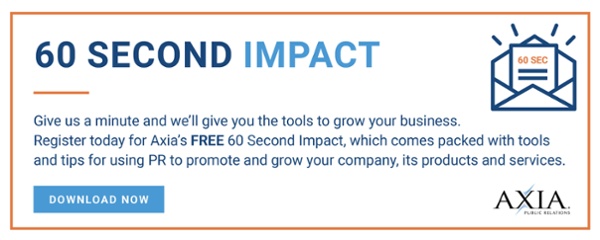 Understanding the difference between “Buy my product” and “This company has a great product that you should try”
Understanding the difference between “Buy my product” and “This company has a great product that you should try”
Most businesses are aware that they need promotion to tell their story and attract customers. Some believe that the best method is advertising and others put more effort into PR and press releases.
Many companies mistakenly believe that the two terms are basically the same thing and can be used interchangeably. However, advertising and press releases affect your customers in distinct ways and at different points on the buyer’s journey. Understanding the benefits and differences could help you to better influence prospects and increase sales.
How advertising and press releases should be used
-
An advertisement is written for your target audiences. This could be taxpayers, customers, prospects or other key stakeholders. You need to craft your message and carefully select your platform to speak to the right audience.
-
The only audience for a press release is the news media. A press release is not an advertisement; it’s a way to promote your news. Therefore, your target audience is journalists and you need to design your messages to speak to them specifically.
-
With an advertisement, you’re selling your product or service directly to the audience.
-
When you create a press release, you’re promoting an idea for a story.
-
Consumers don’t want to read your press releases. To them, it will seem like a long advertisement filled with extra information they don’t really need.
-
Journalists don’t care about your advertisements. They aren’t interested in hearing your slogans, taking advantage of your super discounts or listening to you drone on and on about the greatness of your product.
How to write for journalists and get media attention
Every company needs positive news coverage or earned media. It’s the equivalent of a third-party endorsement telling everyone how wonderful you are and lending credibility to your announcements. Just think about how you feel when you see an advertisement for a company versus seeing that same company featured on a national news broadcast.
Unfortunately, there’s only so much air time and article space to go around and everyone is fighting for it, so journalists are exceptionally selective about which story ideas make the cut. Most journalists write only one story for every 100 pitches and press releases they receive. Therefore, your press release must stand apart from the rest and it’s vital to know how to make yours more noticeable.
Imagine your busiest day of the week. During this time, you probably have very little patience for someone trying to attract your interest with a long, drawn-out explanation. You want him to quickly get to the point, and it had better be good.
That’s what it’s like for journalists every day. In order to get their attention, start with the facts: who is involved, what they’re doing, where it’s taking place, when it will happen and why I should care.
When writing this information, remember that the journalist probably has no idea who you are or what your company does, so be sure to tell her this information as clearly (and briefly) as possible. Also, check your work and then check it again. Spelling and grammatical errors are the quickest way to cause a journalist to disregard your information.
Most importantly, try to think like a journalist. Ask yourself, “If I didn’t work for my company, would I be interested in this information?”
Get help from PR
A quality PR firm can handle all of this for you. At Axia, we use press releases and other PR tools to help increase your visibility with customers and standing within your industry. Contact us today or register for our 60-Second Impact program for valuable insights on ways to grow your business.
Lisa Goldsberry is a writer for Axia Public Relations with more than 15 years of public relations experience. She specializes in business, higher education and technology PR. Connect with Axia Public Relations on Twitter @axiapr.
Featured image credit: 123rf.com
Topics: public relations


Comment on This Article